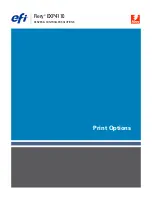
Format
Description
TIFF G42D_Fax
TIFF CCITT.T6 Group 4 2D compressed images
PDF G31D_MH
PDF version 1.3 with Group 3 1D modified Huffman compressed
images
PDF G42D_Fax
PDF version 1.3 with Group 4 2D compressed images
Image Logic Characteristics syntax
<ilc> ::= "1" | "2" | "3" | "4"
Where:
• 1
600 dpi optimised for printing
• 2
300 dpi optimised for viewing and archiving
• 3
600 dpi at 85 lpi optimised for printing on DemandStream and other black & white printers
• 4
600 dpi at 106 lpi optimised for printing on DemandStream and other black & white printers
The <ilc> number sets a number of settings for Image Logic to create an optimal scan for the
defined purpose.
Filename prefix syntax
<filenameprefix> ::= alphanumeric string with a maximum of 8 characters. The string can be
empty.
The filename prefix is used in the name of the exported scan file. Use the filename prefix to select
the type of post processing application, e.g. memo, archive, OCR.
Filename postfix syntax
<postfix> ::= alphanumeric string with a maximum of 30 characters. The string can be empty. The
following characters cannot be used: / \ : * ? " < > | <CR> <LF>.
The filename postfix is used in the name of the exported scan file. Use the filename postfix to
define the behaviour of the application, e.g. application = "email", options = "[email protected]".
User input control syntax
<minnr> ::= numeric string in the range 0..20
<maxnr> ::= numeric string in the range 0..20. <maxnr> must be equal to or larger than <minnr>.
<minnr> and <maxnr> define the minimum and maximum number of user-defined digits for the
Scan Job Type. The user-defined digits are stored in the filename. For example, the user-defined
digits can be used to select a certain archive volume or a telephone number.
When <minnr> and <maxnr> are both 0, the user does not have to enter any digits.
User input dialogue syntax
<namenrdialoguetitle> ::= A user-defined alphanumeric string with a maximum of 40 characters.
The string can be empty. The following characters cannot be used: <CR>, <LF>, "," and ";".
Scan job type specification
310
Chapter 13 - Scan-to-file and scan-to-email
imagePRESS C7010VPS series v2.2
Summary of Contents for imagePRESS C7010VPS series
Page 8: ...Contents 8 imagePRESS C7010VPS series v2 2...
Page 9: ...Chapter 1 Introduction...
Page 14: ...Supported media 14 Chapter 1 Introduction imagePRESS C7010VPS series v2 2...
Page 15: ...Chapter 2 PRISMAsync...
Page 29: ...Chapter 3 The LPD connection...
Page 45: ...Chapter 4 The socket connection...
Page 51: ...Chapter 5 Adobe PostScript 3...
Page 64: ...Bind 64 Chapter 5 Adobe PostScript 3 imagePRESS C7010VPS series v2 2...
Page 86: ...Staple 86 Chapter 5 Adobe PostScript 3 imagePRESS C7010VPS series v2 2...
Page 89: ...Trim Chapter 5 Adobe PostScript 3 89 imagePRESS C7010VPS series v2 2...
Page 99: ...Chapter 6 PDF...
Page 117: ...Chapter 7 Colour management...
Page 133: ...Chapter 8 Accounting...
Page 150: ...Implementation aspects 150 Chapter 8 Accounting imagePRESS C7010VPS series v2 2...
Page 151: ...Chapter 9 SNMP...
Page 159: ...Example in pseudo code Chapter 9 SNMP 159 imagePRESS C7010VPS series v2 2...
Page 222: ...ppmPortGroup 222 Chapter 9 SNMP imagePRESS C7010VPS series v2 2...
Page 223: ...Chapter 10 JDF interface specification...
Page 291: ...Basic JDF ticket Chapter 10 JDF interface specification 291 imagePRESS C7010VPS series v2 2...
Page 297: ...Chapter 11 SMB printing...
Page 303: ...Chapter 12 Hot folder printing...
Page 306: ...Hot folder 306 Chapter 12 Hot folder printing imagePRESS C7010VPS series v2 2...
Page 307: ...Chapter 13 Scan to file and scan to email...
Page 313: ...Chapter 14 SRA IPDS...
Page 361: ......
















































